The blooming pomegranate is a sight to behold: against a backdrop of bright lime-green, lacy foliage, countless coral-red flowers blossom, resembling tiny roses. The pomegranate tree, or simply pomegranate, thrives in the subtropical regions of Western Asia and Southern Europe, and enthusiasts of exotic fruit-bearing plants successfully cultivate it at home.
To make the plant feel at home on your windowsill, it’s essential to provide conditions close to its natural habitat and proper care. Below, we’ll explain how to care for a potted pomegranate indoors.
Table of contents
Key Aspects of Growing Pomegranate at Home
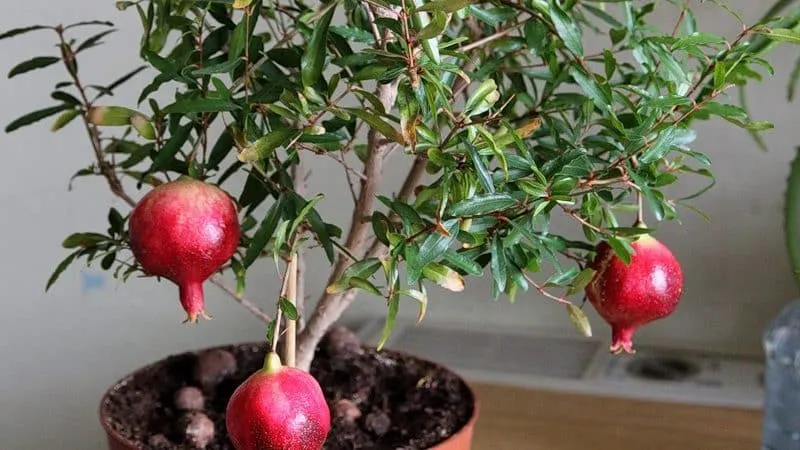
In the wild, the pomegranate tree resembles the mythical phoenix. In arid regions, everything blooms and flourishes only in early spring. Scarlet poppies and tulips wither within days, while the pomegranate leisurely unfurls its delicate leaves and begins to flower by summer, adorning the landscape until September.
These harsh conditions have shaped the plant’s unique biological rhythms and characteristics:
- Drought resistance and the ability to grow in dry air. However, this doesn’t mean you should test the plant’s limits. At room temperature, pomegranates need more frequent watering than they would receive in nature.
- High light requirements.
- Deciduous nature.
- Longevity. With proper care, it can live up to 50 years.
- A dormant period.
- Preference for light, well-drained soil.
Another key trait of pomegranates is their love for fresh air. In spring, once temperatures consistently exceed +16°C, the plant can be moved to an open balcony or terrace and kept there until mid-September (weather permitting).
Note. The pomegranate has no relation to the grenade. Its Latin name, Punica granatum, means "granular."
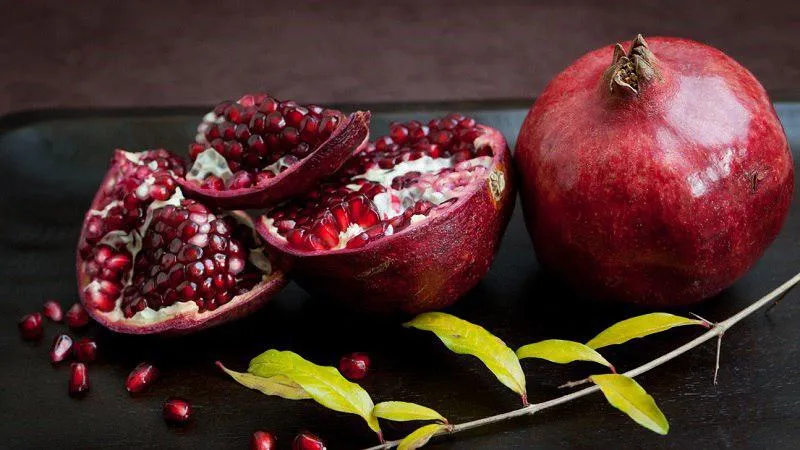
Suitable Varieties
The indoor pomegranate is a group of cultivars derived from the dwarf variety Punica granatum var. nana. In stores, pomegranate trees are often sold without a specific variety name, simply labeled as "Dwarf Pomegranate Nana." The key feature of dwarf varieties is their compact size, typically 60–120 cm tall.
As of 2019, the following indoor cultivars have been developed.
Carthage
A bush reaching up to 100 cm in height, with small emerald-green elliptical leaves arranged oppositely. The flowers are coral-colored, 2.5–4 cm in diameter, blooming from May to August.
The fruits are up to 7 cm in diameter, with a sweet-tart flavor. The skin is thin, and the seeds are small.
Baby
A more compact plant than Carthage (up to 50 cm). This is a bushy, densely leafed shrub. The leaves are light lime-green, up to 3 cm long, elliptical in shape. The branches have sparse thorns. The flowering period begins in March and lasts until November. The flowers are large, up to 7 cm, coral-red.
The fruits are medium-sized, up to 4 cm. To achieve larger fruit, it’s recommended to leave no more than 5 ovaries on the plant.
Important! Not only specialized dwarf varieties but also other types of pomegranates can thrive indoors. The flowers of standard pomegranates are larger than those of dwarf varieties, but don’t expect 500 g fruits from a potted plant.
Ideal Growing Conditions
For a dwarf pomegranate to thrive, it’s crucial to maintain the following conditions (or as close as possible):
- Light. In its natural habitat, the pomegranate tree basks in sunlight. The more light it receives during the day, the better. In autumn and winter, supplemental lighting with grow lamps in the morning and evening is beneficial. The exception is direct sunlight in March and June–July, when the plant needs light shading with gauze or thin white garden fabric.
- Location. The brightest window in the house (north-facing windows are unsuitable).
- Temperature. During the growth period, keep the plant at +22–25°C. When fruits form and grow, maintain a temperature of +14–16°C.
- Humidity. Indoor pomegranates tolerate dry air well and thrive at 50–60% humidity.
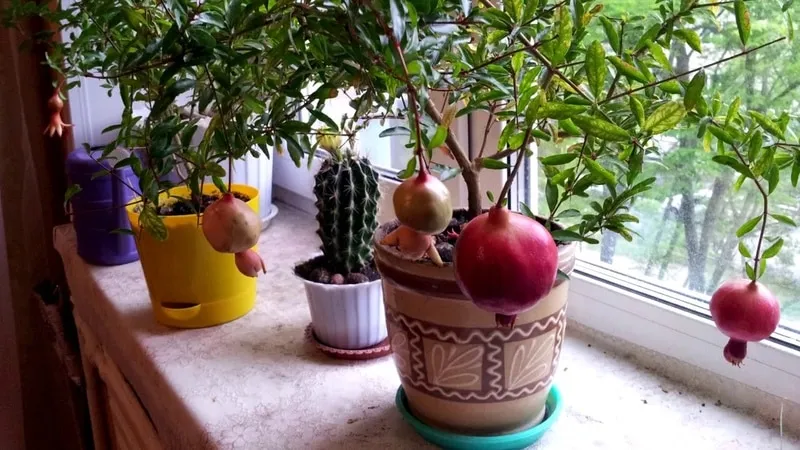
Preparation
Before planting, gather the necessary tools and materials.
Container
First, choose an appropriate container. For store-bought mature plants, use a shallow and snug pot (the tighter the space, the fewer sterile bell-shaped flowers will form). For cuttings and seeds, use plastic containers, trays, or cups (many gardeners repurpose paper bags or dairy product containers).
Clean all containers thoroughly with dish soap (or better yet, castile soap) and disinfect with a strong potassium permanganate solution (2–3 g of powder per 100 ml of water).
Soil
Pomegranate trees need light, neutral-pH soil (pH = 6.5–7). In the wild, they grow in poor, dry sandy or rocky soils. However, this doesn’t mean soil fertility is unimportant. In rich, humus-heavy soil, the shrub flowers more abundantly and produces larger fruit.
For indoor pomegranates, use the following soil mix:
- sod soil;
- compost;
- leaf mold;
- sand.
Mix all components in equal parts. Add fine expanded clay for better aeration. Dwarf pomegranates are susceptible to whitefly infestations, so before planting, drench the soil with boiling water (to kill larvae) and treat it with a solution of a chemical pesticide like "Provado." Prepare the solution with warm water. Dosage: 8 g per 10 L of water.
Planting Material
After purchasing a plant, keep it in quarantine for 3–5 days. This helps ensure no pests or diseases were introduced. It also allows the pomegranate to acclimate to its new environment. Water the plant thoroughly an hour before transplanting.
How to Plant a Pomegranate Correctly
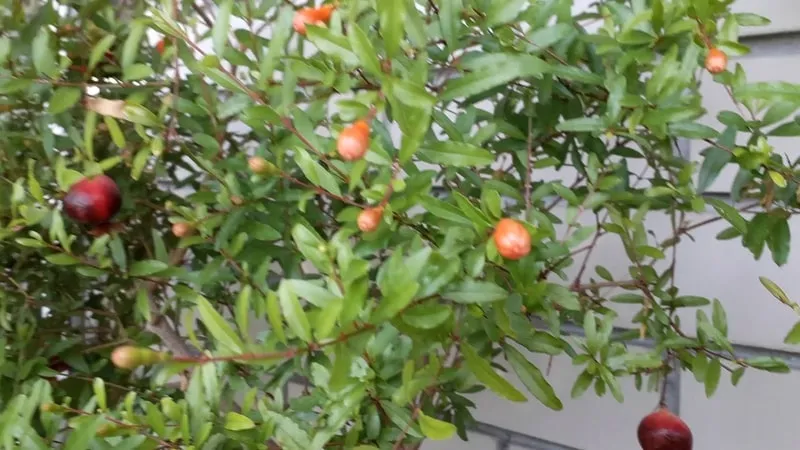
If the pomegranate is purchased in spring or summer, transplant it after quarantine. In autumn or winter, delay repotting until the following spring.
Step-by-step transplanting guide:
- Choose a clean, shallow container 20–30 mm larger than the previous pot.
- Cover the drainage hole at the bottom with a clay shard or large expanded clay.
- Add a layer of expanded clay, followed by 1 cm of sand.
- Place a mound of prepared soil on top.
- Remove the plant from its pot, gently loosen the roots with a garden fork, and trim any dead roots.
- Fill the pot with soil, lightly tamping it down with a wooden stick to eliminate air pockets where roots can’t access water or nutrients.
- Water thoroughly with plain water or a "Superthrive" solution to encourage rooting (1 ampoule per 10 L of water).
After transplanting, the plant may pause growth or shed some leaves—a normal reaction. If the condition doesn’t improve within a week, repeat the "Superthrive" treatment.
Ongoing Care
Plants that have been successfully transplanted require proper care.
Watering
The signal for thirst is dry soil at a depth of 2 cm. Watering frequency depends on room conditions (humidity, light, temperature).
Under ideal conditions, water as follows:
- Summer: daily or every other day.
- September: gradually reduce frequency.
- November–March: once a week.
In spring, water every 1–2 days. In addition to root watering, daily misting is beneficial in spring and summer, especially if temperatures exceed +25°C.
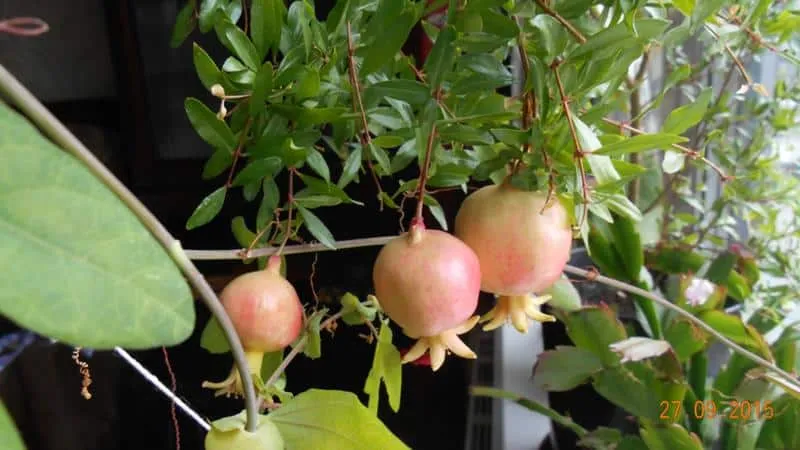
Fertilization
Proper fertilization ensures abundant flowering and fruiting. Fertilization schedule:
- Mid-March: water with a wood ash solution (1 tsp sifted ash per 10 L water).
- Early April: water with a diluted manure solution (1 tbsp per 1 L water).
- Every 2 weeks until September: feed with any liquid fertilizer for indoor fruit plants.
- Early September: apply a final phosphorus-potassium fertilizer (1 tbsp per 10 L water).
No fertilization is needed in winter.
Pruning and Shaping
Pomegranate branches grow chaotically and densely. The key rule is to prune aggressively, removing small, weak branches. Do this in January before leaves appear. Continue pruning as needed, always removing small, unproductive growth. A well-shaped plant should have 4–6 main branches.
For a tree-like shape, leave one main trunk, pinch it at 15–20 cm, and shape the scaffold branches. For standard trees, remove any suckers.
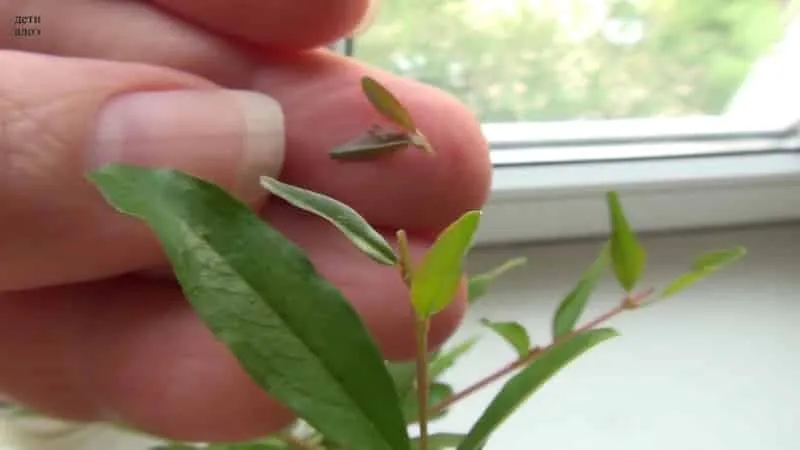
Pest and Disease Control
Pests usually enter with new plants or store-bought soil.
Common pests include:
- whitefly;
- scale insects;
- spider mites.
These can be eliminated with a single treatment of a Class 3 pesticide like "Provado" or "Neem Oil." Isolate the plant after treatment and monitor its condition.
Diseases are typically caused by poor care:
- Yellowing leaves: due to high temperatures, dry soil, or iron/molybdenum deficiency.
- Leaf drop: natural before dormancy or due to underwatering.
- Leaf or branch withering: root issues from over/underwatering (mold, root rot, canker).
Before treating, identify the cause. Inspect the plant, adjust watering if needed, and apply "Superthrive" or similar. If no improvement occurs, check the roots for rot, trim affected areas, dust with "Rooting Hormone," and repot.
Dormancy Period
From November to March, the plant rests. Lower temperatures to +16–18°C and reduce watering. If a basement or balcony isn’t available, place the plant near a window and separate it from the room with plastic film.
Note: Without winter dormancy, pomegranates grow poorly, become disease-prone, and lose varietal traits. Aim for at least 2 weeks of rest.
Propagation Methods
Pomegranates can be propagated by seeds or cuttings.
Cuttings
Start in late February or early March. Select 1-year-old cuttings (20–25 cm long). Trim below a node at the base and between nodes at the top. Treat the base with "Rooting Hormone."
Rooting methods:
- In water: place cuttings in water for 2–3 weeks.
- In soil: use universal soil mixed with perlite/vermiculite, cover with plastic, and keep moist for 2–4 weeks.
Transplant using the same method as above.
Seeds
Use fresh seeds, not dried pits. Soak for 6–8 hours in a growth stimulant or aloe vera juice. Sow in pure peat or a peat-sand/perlite mix. Cover with plastic until germination, then move to bright light. Transplant seedlings at 4–5 cm tall.
Repotting
Repot annually until the plant is 5 years old. Mature plants need repotting every 3–5 years. Follow the same steps as initial planting.
Conclusion
Among all subtropical fruit-bearing houseplants, the pomegranate is the most beginner-friendly. Unlike citrus or feijoa, it doesn’t demand strict dormancy periods or specific humidity-temperature combinations.
With timely pruning and feeding, it rewards care with stunning blooms. The mini-fruits fascinate children, making pomegranate care a fun family hobby.







